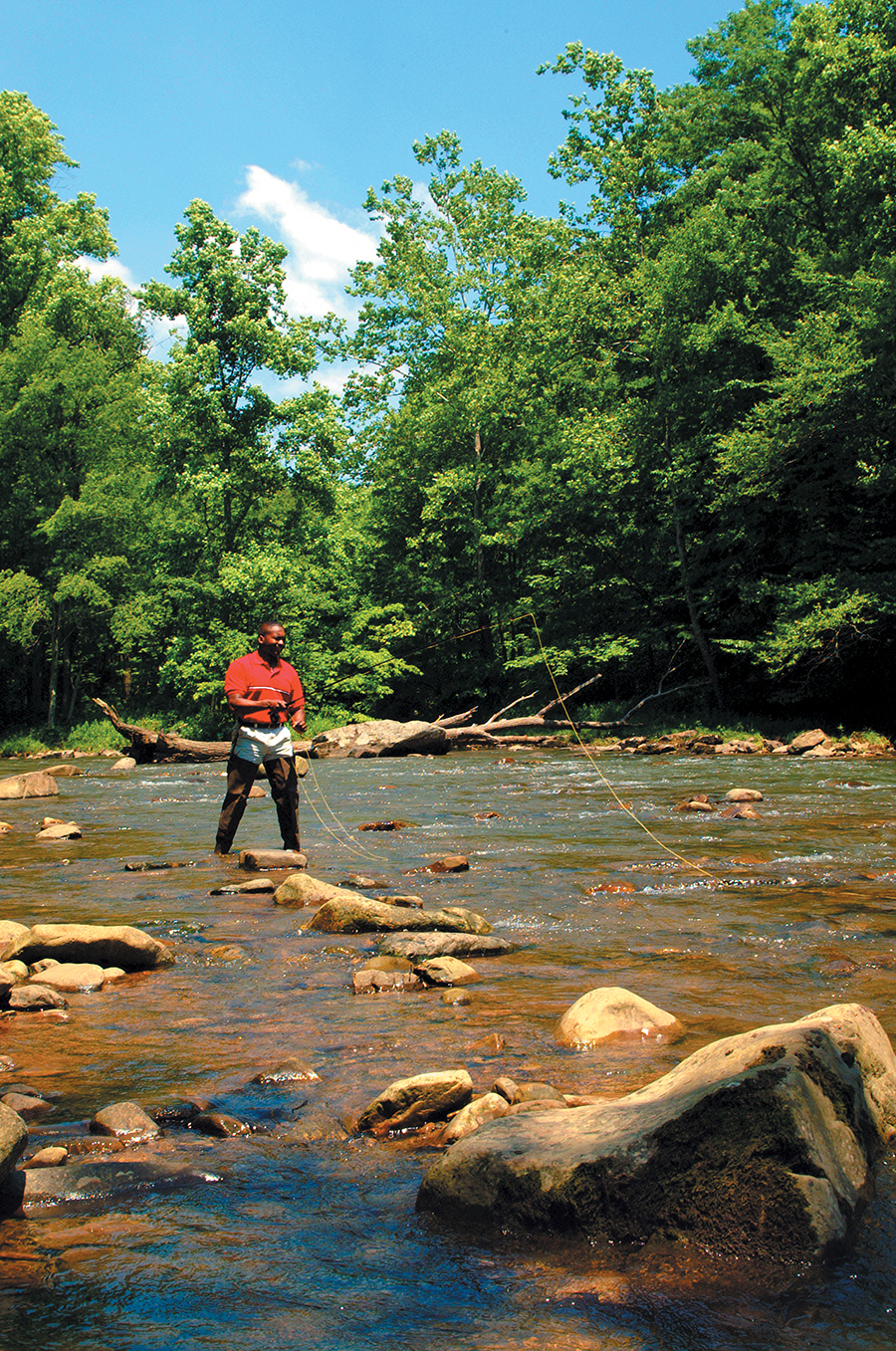Huntingtonians must head to higher elevations and eastern West Virginia’s cool running waters to reel in some of the state’s mouth-watering trout.
By John McCoy
HQ 54 | WINTER 2005
Huntington is a city blessed by water. None of it, unfortunately, happens to be trout water. Trout require cold, oxygen-laced water, the kind found mostly at elevations of 2,000 feet or more. At a mere 569 feet above sea level, Huntington’s streams and rivers lie much too low to remain sufficiently cold. For most Tri-State residents, then, trout fishing means travel.
Die-hard trout junkies can get a quick fix at Lake William in Barboursville Park, Lick Creek Pond near Beech Fork Lake, the Beech Fork Lake tailwaters or Underwood Lake near Lesage. All receive wintertime stockings and are open to the public.
Functional as they are during cold weather, Huntington’s local trout fisheries fall short in two key areas: One, they’re strictly seasonal fisheries. When the weather warms up in late April and early May, all the uncaught trout die. Two, they aren’t exactly eye pleasing.
Spring and summer anglers who prefer to fish classic trout water — clear, rock-lined streams that tumble through scenic woodlands — must drive at least three hours east to capture the experience.

There they’ll find the Cranberry River, the Crown Jewel of Mountain State trout fisheries.
Born high on the flanks of Pocahontas County’s Kennison Mountain, the Cranberry flows 28 miles from its headwaters in the Cranberry Glades to its confluence with the Gauley River. Every inch is prime trout water.
Its South Fork headwaters harbor native brook trout. A little farther down, wild brown trout become the dominant species. From the South Fork’s junction with the North Fork, the Cranberry supports every species of trout the state stocks — rainbow, brown, brook and golden rainbow.
Sixteen miles of the river, from the Glades to the U.S. Forest Service’s Cranberry Campground, flow behind locked gates. A dirt road parallels the river throughout the stretch, but motorized vehicles aren’t allowed. Anglers have a choice: walk, ride a horse or peddle a bicycle.
Those 16 miles contain most of the river’s finest fishing. The state manages the 3 1/2-mile stretch from the North-South junction downstream to Dogway Fork for catch-and-release, artificial lures-only angling. Another one-mile section, 11 miles downstream near Woodbine, has been set up as a “youth fishery” open to boys and girls age 12 and under.
Primitive campsites are scattered all along the river. Twenty-eight rustic campsites can be found at the Cranberry Campground and 33 more are available at nearby Summit Lake. The Four Seasons Motel (800-829-4605) and Mountaineer Motel (304-846-2020) in nearby Richwood are popular jumping-off spots for anglers who prefer warm beds and hot showers.

One ridge over from the Cranberry lies its sister stream, the Williams River. The major difference between the two is that fishermen can reach the Williams by car along virtually its entire length. The stream’s headwaters contain native brook trout and wild browns. Stocked waters begin at Day Run and continue all the way downstream to Dyer. Like most high-quality West Virginia trout streams, the Williams receives weekly stockings from March 1 to May 31.
In the Williams’ case, however, the really good fishing seems to begin shortly after the stockings end. As spring gives way to summer, the river’s water levels drop and its trout become much more accessible to wading anglers.
Division of Natural Resources officials maintain a two-mile stretch of the Williams for catch-and-release, artificial-lures-only angling. The section begins two miles below the mouth of Tea Creek.
The Williams is a camper’s dream. The Forest Service has spaced more than 20 individual primitive campsites at regular intervals along the stream, and the Day Run and Tea Creek campgrounds provide 12 and 29 rustic sites, respectively. Motel rooms can be found in Marlinton at the Rustic Inn (304-799-4204) or the Marlinton Motor Inn (800-354-0821).
Anglers who prefer to fish for difficult trout will enjoy the many challenges the upper Elk River presents. From Randolph County’s Elk Springs downstream to the Webster County seat of Webster Springs, the Elk harbors large, finicky brown trout. The trout grow large because they dine on a rich smorgasbord of aquatic insects. They grow finicky because they’ve seen every variety of bait, lure and fly that could be thrown at them.

The Elk’s persnickety browns have actually spawned an arcane brotherhood, a “cult of the minuscule trout fly.” Hardcore Elk fly fishermen have discovered that the river’s ultra-shy trout are most easily caught on gnat-sized patterns that more closely resemble dandruff flakes than insects. A two-mile section of the Elk, from Elk Springs downstream to Rose Run Bridge, generates most of the small-fly insanity. DNR officials manage the stretch under catch-and-release, artificial lures-only regulations.
More traditional angling methods hold sway from Rose Run downstream to Webster Springs. Rainbow trout supplant browns as the dominant species, and the weekly-stocked waters fall under the DNR’s standard six-trout daily creel limit.
Lodging along the upper Elk is non-existent. The closest accommodations are at Snowshoe Mountain Resort (877-441-4386) and at the Mineral Springs Motel (304-847-5305) in Webster Springs.
Equally remote are the waters of Shavers Fork. From its birthplace high on Cheat Mountain near the Snowshoe ski resort, this major Cheat River tributary flows more than 30 miles through a remote, nearly roadless section of the Monongahela National Forest.
Upstream, near the old mining town of Spruce, brook trout are the dominant species. Farther downstream, below First Fork and Second Fork, rainbows and browns become more prominent.
Forest Service roads provide access to roughly 10 miles of river upstream of Cheat Bridge. U.S. Route 250 parallels the stream for about four miles downstream of that point. From there, access is limited to five points — the Forest Service roads that parallel Whitmeadow, Yokum, Crouch and McGee Runs, and County Route 22 at Bemis.
Catch-and-release, artificial lures-only regulations govern the 5 1/2-mile section of Shavers between Whitmeadow and McGee Runs.
Anglers intimidated by Shavers’ size and swift currents can find more friendly waters in most of the river’s Cheat Mountain tributaries. Most of them are brook-trout streams. A few harbor rainbows and browns as well.

The Hermitage (304-456-4808), located 10 miles from Cheat Bridge in Bartow, provides both lodging and a restaurant for Shavers Fork anglers.
No tour of West Virginia’s best trout streams would be complete without a side trip to Gandy Creek in eastern Randolph County.
Native brook trout and wild brown trout inhabit Gandy along its entire length. County Route 29 parallels the stream for miles, providing easy access and parking for anglers.
Compared to the other streams profiled in this article, Gandy is small water. Its waters are easily waded, and its intimate nature allows anglers to make short, comfortable casts. Campers have their choice of the Forest Service’s 28-site campground at Spruce Knob Lake, or three private campgrounds in nearby Harman: Cooper’s Campground (304-227-4197), Little Tory Campground (304-227-4533), or Harman Mountain Farm Campground (304-227-3647). The closest sizable motel accommodations are available at the Canaan Valley Resort (304-866-4121).
The aforementioned streams are by no means the only trout waters West Virginia’s mountain highlands have to offer. They do, however, represent “the best of the best.” Huntington-area anglers who make an effort to explore them will be rewarded — if not in trout caught, then at least in scenery enjoyed, wildlife viewed and tranquility absorbed. Enjoy!





